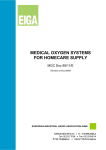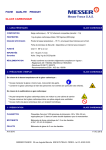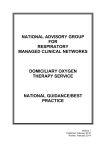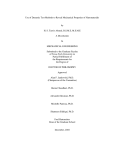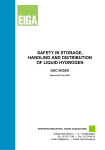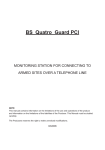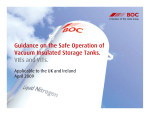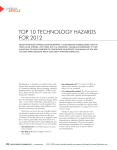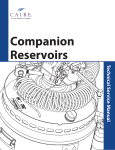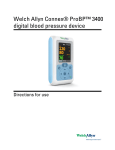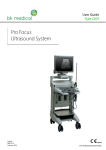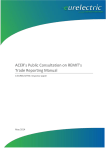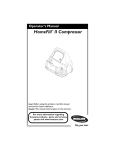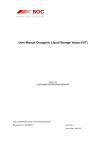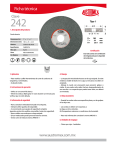Download "user manual"
Transcript
MEDICAL GASES SAFE SUPPLY OF TRANSPORTABLE MEDICAL LIQUID OXYGEN SYSTEMS BY HOMECARE SERVICE PROVIDERS MGC Doc 98/09/E Revision of Doc 98/03 EUROPEAN INDUSTRIAL GASES ASSOCIATION AISBL AVENUE DES ARTS 3-5 • B-1210 BRUSSELS Tel : +32 2 217 70 98 • Fax: +32 2 219 85 14 E-mail : [email protected] • Internet : http://www.eiga.eu MGC Doc 98/09/E nn SAFE SUPPLY OF TRANSPORTABLE MEDICAL LIQUID OXYGEN SYSTEMS BY HOMECARE SERVICE PROVIDERS PREPARED BY : Jan STRYBOL AIR PRODUCTS MANAGEMENT Mercedes FRANCO CARBUROS METALICOS David OWERS LINDE GROUP Clément MAKOWIECKI AIR LIQUIDE SANTE Renato COMI VIVISOL Nik DE CORTE MESSER GROUP Garcia PRIETO PRAXAIR Disclaimer All technical publications of EIGA or under EIGA's name, including Codes of practice, Safety procedures and any other technical information contained in such publications were obtained from sources believed to be reliable and are based on technical information and experience currently available from members of EIGA and others at the date of their issuance. While EIGA recommends reference to or use of its publications by its members, such reference to or use of EIGA's publications by its members or third parties are purely voluntary and not binding. Therefore, EIGA or its members make no guarantee of the results and assume no liability or responsibility in connection with the reference to or use of information or suggestions contained in EIGA's publications. EIGA has no control whatsoever as regards, performance or non performance, misinterpretation, proper or improper use of any information or suggestions contained in EIGA's publications by any person or entity (including EIGA members) and EIGA expressly disclaims any liability in connection thereto. EIGA's publications are subject to periodic review and users are cautioned to obtain the latest edition. EIGA 2009 - EIGA grants permission to reproduce this publication provided the Association is acknowledged as the source EUROPEAN INDUSTRIAL GASES ASSOCIATION AISBL Avenue des Arts 3-5 B 1210 Brussels Tel +32 2 217 70 98 Fax +32 2 219 85 14 E-mail: [email protected] Internet: http://www.eiga.eu MGC DOC 98/09 Table of Contents 1 Introduction ...................................................................................................................................... 1 2 Scope and Purpose ......................................................................................................................... 1 2.1 2.2 2.3 Scope .................................................................................................................................... 1 Purpose ................................................................................................................................. 2 Definitions ............................................................................................................................. 2 3 Characteristics of oxygen................................................................................................................. 2 4 Hazards with handling Liquid Oxygen ............................................................................................. 2 5 Precautions when Handling Liquid Oxygen ..................................................................................... 3 6 Emergency Actions .......................................................................................................................... 5 7 General Description of Equipment ................................................................................................... 5 8 Initial Installation of the Transportable Liquid Oxygen Systems ...................................................... 5 8.1 8.2 8.3 8.4 9 Initial Assessment ................................................................................................................. 5 Equipment Preparation ......................................................................................................... 6 Initial Installation.................................................................................................................... 6 High Flowrate Requirements ................................................................................................ 7 Storage of the Transportable Liquid Oxygen Systems .................................................................... 8 9.1 9.2 10 10.1 10.2 10.3 Storage of the TLOS at the Patient's Home.......................................................................... 8 Storage of the TLOS at the Healthcare Facility .................................................................... 8 Service Provider Checks for the TLOS ........................................................................................ 9 Service Provider Checks for the Base Unit ........................................................................... 9 Service Provider Checks for the Portable Unit ..................................................................... 9 Service Provider Checks for the Disposable Accessories .................................................... 9 12 Operation and Use of the Transportable Liquid Oxygen Systems............................................. 10 13 Transfilling of the Portable Unit .................................................................................................. 10 14 Travelling with Transportable Liquid Oxygen Systems .............................................................. 11 15 Maintenance and Cleaning of the Transportable Liquid Oxygen Systems ................................ 12 16 References ................................................................................................................................. 13 Appendix 1 TLOS Troubleshooting Guide - Service Provider at the Patient's Home..................... 14 Appendix 2 Typical Patient Questions concerning TLOS ............................................................... 17 Appendix 3 Typical Patient Equipment Checklist and Acknowledgement Form ............................ 19 Appendix 4 Patient User Instruction Card....................................................................................... 20 Appendix 5 Patient User Training Card .......................................................................................... 21 1 MGC 1 DOC 98/09 Introduction Medical Liquid Oxygen is a well established method of supplying patients with supplementary oxygen either in their homes or in healthcare facilities, where permitted, according to the national regulations. Liquid Oxygen for medical oxygen therapy is supplied in a Transportable Liquid Oxygen System (TLOS), which comprises a base unit and its associated portable unit. The equipment used with medical oxygen therapy shall be CE marked to indicate that they comply with the requirements of the Medical Device Directive 93/42/EEC as amended by EC Directive 2007/47 (valid for all equipment purchased after the 14th June 1998). In addition this equipment is required to comply with the European Agreement on the Transport of Dangerous Goods, ADR regulations, and shall be 'π' marked to show compliance with the Transportable Pressure Equipment Directive, (TPED) 1999/36/EC (when put on the market after 1st July 2001). It is the responsibility of the doctor to prescribe the correct flowrate for the patient and the responsibility of the Homecare Service Provider to supply a package that ensures that the patient receives the prescribed flowrate. As a part of this responsibility, the Homecare Service Provider shall also instruct the patient on how to use the equipment correctly and how to select the prescribed flowrate. In addition this document provides a simple guide for the Homecare Service Provider to give to the patient, carer or healthcare facility staff to emphasise the safe use and storage requirements for medical liquid oxygen supplies, both in the home and in healthcare facilities. 2 Scope and Purpose 2.1 Scope This document covers the use of TLOS, used to supply medical liquid oxygen to patients at home or in healthcare facilities as a stand-alone therapy supply system. It includes the operational specification of the TLOS to provide the patient with the prescribed flowrate but excludes its basic design requirements, which are detailed in EN 1251 – 2, Cryogenic vessels – Part 2: Design, Fabrication, Inspection and Testing. Other relevant documents are: MGC 89/09 Medical Oxygen Systems for Homecare Supply. IGC 141/07 Planning oxygen supplies for respiratory patients when travelling EN ISO 18777 Transportable Liquid Oxygen Systems for medical use – Particular Requirements. BCGA TIS No 14 Safety Precautions and Risk Management when dealing with Domiciliary Oxygen Incidents. This document specifically does not cover: • • • • the filling and handling of the TLOS base unit by the Medical Oxygen Healthcare Service Provider. the Good manufacturing Practice GMP and traceability requirements concerned with the supplies of medicinal gases, which are covered by the EIGA document ' Good Manufacturing Practice Guide for Medicinal Gases' the traceability of medical equipment, which is covered by EC Directive, 93/42 EEC as amended by EC Directive 2007/47. the requirements for liquid oxygen vessels used on manifold systems, to supply medical oxygen to healthcare facilities via a pipeline system, which is covered by EN ISO 7396-1, Medical Gas Pipeline Systems - Part 3: Pipeline Systems for Compressed Medical Gases and Vacuum. The general requirements for the supply and safe use of medical oxygen are given in MGC Document 89/09. 1 MGC 2.2 DOC 98/09 Purpose The purposes of this document are to give guidance on: • • • 2.3 the specific safety issues related to the handling and use of medical liquid oxygen. safety precautions recommended for the Homecare Service Provider for installing, handling and maintaining the TLOS. safety precautions recommended to be given to the patient / carer when using and handling the TLOS and transfilling the portable unit. Definitions Homecare Service Provider An organisation / company that provides the medical oxygen and the medical oxygen equipment for treating patients either in their home or supplied direct to the Healthcare Facility treating the patient. Healthcare Facility An organisation / company providing the medical oxygen therapy to the patient on their premises, where they are responsible for the care of the patient, e.g. hospital or Care-home. TLOS Transportable Liquid Oxygen System, comprising of the base unit and the portable unit that can be filled from the base unit. Base Unit A mobile device that is vacuum insulated intended to store oxygen and maintain it in the liquid state for the purpose of refilling portable units and that can include an internal vaporiser and a flow control valve for the direct supply of gaseous oxygen to the patient. Portable Unit A portable device including a vacuum insulated cryogenic vessel to maintain liquid oxygen at cryogenic temperatures, an internal vaporiser and a flow control to provide gaseous oxygen to the patient. The portable unit can be filled from the base unit by the patient. 3 Characteristics of oxygen The basic characteristics of oxygen are: • • • • • • 4 Oxygen is an essential requirement to sustain life and is normally supplied from the earth’s atmosphere, which is made up of approximately 20.9% oxygen. Gaseous oxygen is a colourless, odourless, tasteless gas with a specific density of 1.1 (relative to air). Liquid oxygen is a light blue liquid that flows like water. Liquid oxygen has a boiling point of -183.0 °C at atmospheric pressure and has a specific density of 1.14 (relative to water). One volume of liquid oxygen will generate 860 volumes of gaseous oxygen at atmospheric pressure and temperature. Oxygen, in gaseous or liquid form, is a non-flammable, non-toxic powerful oxidiser. Hazards with handling Liquid Oxygen When making the initial supply of medical liquid oxygen, advice shall be given to the patient / carer or Healthcare Facility representative to explain the general hazards when using medical liquid oxygen in a TLOS and shall include the following information: • Liquid oxygen is extremely cold and boils at -183.0 °C at atmospheric pressure. Touching any cold surfaces on the TLOS, such as the valves, pipes or couplings, can cause sever 2 MGC • • • • • • • 5 DOC 98/09 cryogenic burns or frostbite. When handling the TLOS, do not allow liquid oxygen or frosted pipework to come in contact with the skin or non-protective clothing. Moisture can accumulate on exposed surfaces of equipment containing liquid oxygen forming ice, causing components such as valves or filling couplings to freeze open or shut. If moisture is permitted to enter liquid oxygen lines or systems, it will freeze and may prevent components such as pressure relief devices or control valves from functioning properly, which could result in a potentially unsafe condition. One volume of liquid oxygen at standard atmospheric pressure when vaporised will produce approximately 860 volumes of gaseous oxygen at ambient temperatures. The large volume of gaseous oxygen resulting from the vaporisation of liquid oxygen has the potential, if trapped in a closed circuit not adequately protected by pressure relief devices, to generate gas pressures high enough to cause explosive rupture of containers, transfer piping or other system components. Care shall be taken to avoid blockage of the outlets of vent lines, ports and safety relief devices, for instance by dirt or ice. Due to the extremely cold temperature of liquid oxygen, it will constantly absorb heat through the vessel walls, which will produce gaseous oxygen. Any gaseous oxygen produced in excess of the patient’s requirements will be automatically vented, generating an oxygenenriched atmosphere. It is important to keep the TLOS in a well-ventilated area to avoid the generation of oxygen-enriched atmospheres and to keep it away from combustible materials and protected from exposure to heat sources, which may accelerate the venting of oxygen from the vessel. The density of the low temperature gas vented from a TLOS is heavier than air and will accumulate in low-lying areas if not adequately ventilated. Materials that burn in air will burn much more vigorously in oxygen and burn at a higher temperature in an oxygen or oxygen-enriched atmosphere. Most serious incidents involving the use of medical oxygen are caused by the patient smoking Oils and grease burn in an oxygen-enriched environment with explosive violence. Ignitions may occur with oxygen equipment if it has been contaminated with oil or grease. This can be caused by handling equipment with hands that have been contaminated with petroleum jelly or hand/face creams containing petroleum-based ingredients or using tools contaminated with oil or grease. Absorbent materials, such as clothing or bedding, when saturated with oxygen, will readily ignite. These materials remain oxygen-enriched for some time after removal from the oxygen source Precautions when Handling Liquid Oxygen To ensure the safe operation of TLOS, the following instructions shall be provided to the patient / carer / Healthcare Facility representative in the form of operating instructions. A typical Patient User Instruction Card that can be supplied to the patient and / or carer when the equipment is initially installed at the patient’s home or Healthcare Facility is given in Appendix 4. Appendix 5 gives a typical Patient User Training card that can be used by the Homecare Service Provider to instruct the patient or carer. It covers the correct operation of the unit and the safety precautions that shall be followed. It may be appropriate for both Cards to be left with the patient or carer to provide additional information. In addition, the TLOS User Manual shall also be provided to the patient / carer. Where the User Manual specifies a different way of using, handling or transfilling the TLOS, the information provided to the patient should be reviewed to ensure that there is no contradiction between the information supplied and the manufacturer's instructions. The basic precautions to be given to the patient / carer / Healthcare Facility representative shall cover the following information: • • • • Most serious incidents involving the use of medical oxygen are caused by the patient smoking. Instructions shall be given to the patient / carer or Healthcare Facility representative to: never smoke whilst using their medical oxygen equipment never allow any other person to smoke in the vicinity of the patient using their medical oxygen 3 MGC • • • • • • • • • • • • • • • • • • • • • • DOC 98/09 keep sources of ignition, including lit cigarettes, gas cookers, electrical toys and equipment or open fires away from areas where medical oxygen is used or stored. It is advisable that 'No Smoking' symbols and instructions shall be displayed on TLOS When handling the TLOS never touch any frosted parts or allow liquid oxygen or frosted pipe work to come in contact with the skin or non-protective clothing. If suffering from a cold burn, the affected part should immediately be immersed in tepid water and a doctor contacted immediately for further advice Never use oils and grease on any oxygen equipment because these materials will burn in an oxygen-enriched environment with explosive violence. TLOS shall only be used and stored in areas away from sources of ignition such as lighted cigarettes, gas cookers, electrical toys and equipment or open fires. Oxygen equipment shall only be handled or operated with clean hands and tools and the equipment shall be kept clean, taking specific care to keep the filling couplings clean. Where available, the filling coupling cover should be fitted when not in use. Petroleum jelly or hand and face creams containing petroleum-based ingredients shall never be used with medical oxygen. Instructions shall be given the patient / carer or Healthcare Facility representative to: only handle or operate medical liquid oxygen equipment with clean hands and tools and to keep the oxygen equipment clean and free from any oils or grease. where the patient requires to use a moisturiser or cream to prevent their nostrils from drying out to only use an acceptable oil-free product that is suitable for use with medical oxygen. Where it is suspected that clothing, carpets or bedding has become saturated with oxygen, it shall be well ventilated to ensure that the oxygen enrichment is cleared. ventilate any clothing or bedding, where it is suspected that it has become saturated with oxygen, to ensure that any oxygen enrichment is cleared. It may take at least 15 minutes to adequately ventilate clothing or 30 minutes to ventilate bedding before it is safe to approach sources of ignition. never use the ambulatory unit under clothing. Where an ambulatory unit is carried in a bag or holder, it must be specifically designed for the unit and be made from appropriate material and provide adequate ventilation. The design shall allow any oxygen that leaks out of the container to escape to reduce the possibility of oxygen enrichment. to prevent any unnecessary enrichment of the air, it is important that patients / carers are instructed that the oxygen system must be turned off when not in use. Only trained persons shall be allowed to operate the medical oxygen equipment. Special care needs to be taken to ensure that children are not allowed to tamper with the equipment. In order to ensure that the medical oxygen flow rate remains satisfactory. The total length of the flexible unsupported tubing, from supply source to the connection to the nasal cannula or mask shall be kept to a minimum, but in any case no more than 15 meters. If tubing is fixed to the walls to provide outlets in different rooms, this shall be with no constrictions at corners etc. The TLOS shall never be covered with material or stored adjacent to curtains as they may become oxygen enriched. The TLOS shall be kept in a well-ventilated area to avoid the generation of oxygen-enriched atmospheres. They shall also be kept away from combustible materials and protected from exposure to heat sources, which may accelerate the venting of gaseous oxygen from the vessel. Care shall be taken to avoid blockage of vent lines, ports and safety relief devices. TLOS shall be handled with care and should never be knocked violently, dropped or allowed to fall over These basic precautions shall also be followed by the Homecare Service Provider when installing, handling, transfilling or maintaining the TLOS at the patient's home / healthcare facility. 4 MGC 6 DOC 98/09 Emergency Actions The Homecare Service Provider shall provide the patient / carer or Healthcare Facility representatives with the following emergency action advice: Emergency Actions: • • • If a sustained release of liquid oxygen occurs, stay out of the vapour cloud and the immediate surrounding area, open all external doors and windows and evacuate all persons from the area and contact the Homecare Service Provider immediately. If clothing ignites in an oxygen enriched atmosphere, use a flood of water to extinguish the flame as just smothering the flame from oxygen enriched materials will not extinguish the fire. If a fire occurs, where the TLOS is present, immediately evacuate the area and call the fire brigade. It is important to advise the fire brigade that oxygen is in the premises, even though it may not be involved in the fire. After the incident: If clothing, bedding or furniture has been exposed to a high concentration of oxygen, avoid any sources of ignition until they have either: • been removed • been thoroughly aired to remove any excess oxygen for at least 15 minutes and at least 30 minutes for bedding / furniture • been drenched with water Further information can be read in the BCGA document “TIS No 14 Safety Precautions and Risk Management when dealing with Domiciliary Oxygen Incidents. 7 General Description of Equipment The TLOS consists of two units: • • A base unit that holds the principal supply of liquid oxygen and is filled by the Medical Oxygen Healthcare Service Provider A portable unit, usually intended for ambulatory use that can be filled by the patient or carer from the base unit. The oxygen supply to the patient can be supplied from the flow-regulating device either on the base unit or the portable unit. In some cases, the TLOS is designed so that the portable unit has to be fitted to the base unit in order to supply the oxygen gas to the patient. Some TLOS have an integrated conserving device. It is a normal function of the TLOS that where it is not in continuous use it will eventually start to vent oxygen gas to atmosphere. The base unit is fitted with a liquid oxygen transfer connector to allow it to be filled by the Homecare Service Provider and to permit the transfilling of the portable unit by the patient or carer. The portable unit shall be designed to be filled to a specific type of transfilling connector on the base unit. The Homecare Service Provider shall only supply the patient a portable unit that is compatible with the base unit. 8 Initial Installation of the Transportable Liquid Oxygen Systems 8.1 Initial Assessment When planning the installation and storage arrangements for TLOS, whether used in healthcare facilities or by domiciliary patients at home, an assessment of the property shall be carried out in accordance with the document MGC 89/09. This should ensure that the patient or healthcare worker 5 MGC DOC 98/09 are not subjected to undue risk in the event of any incident with a liquid oxygen vessel that is in use or being stored. For domiciliary patients, the person supplying the TLOS could carry out this assessment. From the results of the assessment, any special circumstances identified for that patient shall be evaluated and the appropriate required actions identified and notified to the patient (or their carer). If the patient’s premises are considered to be unsuitable for the storage and use of the TLOS, the Medical Oxygen Homecare Service Provider shall inform the patient’s prescriber that an alternative method of supplying medical oxygen is required. Excessive stocks of full TLOS will increase the potential of any incident that may occur on site. The Homecare Service Provider shall determine the size and number of the base units to suit the patient's requirements at the prescribed flowrate and delivery frequency. 8.2 Equipment Preparation Prior to installing any equipment in the patient’s home or healthcare facility, it is the responsibility of the Homecare Service Provider to verify that the equipment is functioning correctly, including that the: • • • • • • • • • • vessels are within their periodic statutory test date exterior condition of the TLOS is clean, and not damaged to an extent which impairs the correct functioning of the unit. transfilling connector is clean, not leaking and has no visible sign of damage receiver for collecting condensation on the base unit is both empty and clean patient outlet is clean and in good condition flow control valve is mechanically functioning correctly level indicator, including battery where fitted, is operational TLOS is labelled correctly portable vessel's vent valve is easy to operate portable vessel will connect satisfactorily to the base unit Where the TLOS is found to not conform to any of the above checks, the Homecare Service Provider shall follow the appropriate procedures to either rectify or replace the faulty unit. Parts that can influence the cleanliness of the supply of the oxygen, such as nasal cannula and oxygen tubing shall be renewed before the equipment is installed at a new patient location. The specific manufacturer's instructions shall be followed when transferring any reusable accessories used with TLOS to another patient 8.3 Initial Installation Before use, the patient / carer or the Healthcare Facility representative shall be given adequate training in the operation, handling and cleaning of the TLOS. In addition they shall also receive instructions about the potential hazards and recommended safety precautions for handling the TLOS. If the patient and carer are considered to be incapable of operating the TLOS safely, the Medical Oxygen Homecare Service Provider shall inform the patient’s prescriber that an alternative method of supplying medical oxygen is required. For Healthcare Facilities, it is the responsibility of their appointed representative to ensure that all patients and Healthcare Facility staff are trained in all of the appropriate procedures for handling the TLOS and refilling the portable unit. Specific instructions shall be given to the patient / carer for the transfilling of the portable unit. This training shall be given personally to all persons who will be required to transfill the unit and an assessment shall be carried out at the end of the training session to ensure that they are all competent to complete the task. As part of the training the Homecare Service Provider shall ensure that the portable unit is filled by the patient or carer. The Homecare Service Provider shall supply information required for operating and handling of the TLOS and transfilling the portable unit, including the manufacturer’s ‘Instructions for Use’. The Homecare Service Provider shall agree with the patient / carer on a safe location for the base unit and the area where the portable unit will be transfilled. The base unit should not be positioned in doorways or access routes out of the building. 6 MGC DOC 98/09 In order to ensure that the medical oxygen flow rate remains satisfactory. The total length of the flexible unsupported tubing, from supply source to the connection to the nasal cannula or mask shall be kept to a minimum, but in any case no more than 15 meters. If tubing is fixed to the walls to provide outlets in different rooms, this shall be with no constrictions at corners etc. Where the transfilling is carried out on an adsorbent surface, such as a carpet, the patient / carer shall be informed to ensure that the area is well ventilated to prevent the surface becoming enriched with oxygen in the unlikely event of a spillage. If transfilling is done in the open, it shall never be carried out on an asphalt surface. The Homecare Service Provider shall instruct the patient / carer / Healthcare Facility representative to: • • • • Not place any form of cover over the equipment, as this will restrict ventilation. Specifically do not drape clothing or any other material over the vessel nor store the base unit near curtains, as they may become oxygen enriched and burn vigorously if ignited. For the same reason, the portable unit shall never be carried or used under any clothing. Not to block the outlets of the relief valves Not apply any labels or markings to the TLOS. Not repair any part of the TLOS. When the installation is complete and the training completed satisfactorily, the patient / carer should be requested to sign the Equipment Checklist and Acknowledgement Form (see typical example in Appendix 3). 8.4 High Flowrate Requirements In the majority of circumstances, a single TLOS will be able to supply an adequate flowrate for the patient. Where the patient requires higher flowrates, it is preferable to use a single unit with a higher output provided that it does not lead to icing up of the base unit. Where the prescribed flow exceeds the flowrate capabilities of a single base unit or leads to icing up of the unit, two or more units may be connected to provide the patient's requirements. As this type of patient normally requires high flowrates at all times they can be supplied with a specifically designed high flowrate portable unit (or any other alternative high flowrate system) for exceptional ambulatory use. It is not recommended to connect two portable units to supply high flowrates for practical reasons. When connecting multiple units together the following points need to be considered: • • • The units shall be connected using appropriately designed fittings that will allow the entire system to provide a safe and adequate supply. To set up the system, the multiple units should be connected with 'Y' connectors from the patient outlet on the base units If a humidifier is required, a single unit shall be used fitted after the 'Y' connection to prevent the backflow of water into any of the units, due to pressure differences The total flowrate from multiple connected TLOS' may not be the simple summation of the flowrates set on each individual flow regulation device. To avoid inaccurate flow control, it is advisable to connect an additional flow-regulating device downstream of the interconnection and to control the flow to the patient at the prescribed flowrate, having fully opened the flow selector valves on both units. The multiple units should be installed as close as possible to the patient to minimise the pressure drop in the supply line. If a humidifier is required, it shall be installed downstream of the additional flow regulating device. Use base units of the same size so that the units can be refilled at the same time to prevent one unit emptying before the other unit, leading to a reduced flowrate. Ensure that the oxygen tubing is of a sufficient size to be able to deliver the flowrate required. As addition oxygen is being stored in the patient's home, it is important to consider the storage and ventilation requirements when carrying out the assessment. 7 MGC DOC 98/09 9 Storage of the Transportable Liquid Oxygen Systems 9.1 Storage of the TLOS at the Patient's Home The TLOS shall always be stored in a covered area and preferably indoors, but in any case in a secure place away from the public. The most suitable locations for installing the TLOS at the patient’s home will normally be either in a living room or bedroom but when agreeing the storage arrangements in the patient's home, the patient / carer shall be advised to consider the following requirements: • • • • • As the TLOS will periodically release small amounts of oxygen gas, keep the units in a wellventilated area. Allow air circulate around the unit at all times to prevent any significant oxygen enrichment in the vicinity. Never store the TLOS in small and closed areas such as cupboards. Never store the TLOS within the immediate vicinity of sources of ignition because the atmosphere around the TLOS may become oxygen enriched by the venting of the vessel. Storage position of the TLOS should be sited so that the delivery vehicle can safely offload onto a level floor. Where ever possible keep the TLOS at least 1.5 metres away from: o electrical appliances such as televisions, air conditioning fans or hair dryers o heating sources or stoves (where there are no open flames). Where ever possible keep the TLOS at least 3 metres away from: o • 9.2 open fires and any naked flames o heating sources or stoves with open flames. When selecting a storage place at the patients home, avoid placing the TLOS: o in corridors and hallways or near doorways. o where they could impede patient’s or carer’s movement o where they may be bumped into or tipped over. Storage of the TLOS at the Healthcare Facility When planning the storage of TLOS in a Healthcare Facility, the following additional advice concerning the storage of significant numbers of base units, they shall be advised that the storage area shall be: • • • • • • • • • covered, preferably inside and not subjected to extremes of heat kept dry, clean and well ventilated, with ventilation grilles preferably at both high and low level designed to have a floor constructed / covered with a non-flammable material large enough to allow for segregation of full and empty vessels, with the different storage areas being well signed totally separate from any non-medical gas storage areas sited to have good access for the delivery vehicle to enable vessels to be off loaded safely onto a reasonably level floor located away from any sources of heat or ignition and storage tanks containing highly flammable materials and other combustible materials designed to prevent unauthorised entry to protect vessels from theft provided with warning notices prohibiting smoking and naked flames within the vicinity of the store Where TLOS’s are stored in remote ‘in use’ storage areas nearer the point of use (adjacent to patient ward areas) the storage conditions above shall be observed. Stocks in the ‘in use’ stores should be kept to a minimum to reduce the potential risk to patients and staff should there be an incident. 8 MGC DOC 98/09 10 Service Provider Checks for the TLOS 10.1 Service Provider Checks for the Base Unit Each time that the base unit is supplied to the patient or to the Healthcare Facility, the Homecare Service Provider shall check that the: • • • • • • • • • • exterior condition of the base unit clean and not damaged to an extent which impairs the correct functioning of the unit. transfilling connector is clean and in good condition transfilling connector is not leaking receiver for collecting condensation is both empty and clean patient outlet is clean and in good condition flow control valve is functioning correctly. level indicator, included battery where fitted, is operational vessels have no cold spots indicated by frosting TLOS is not leaking (other than from the relief valve, which is a normal function for a serviceable unit) base unit is labelled correctly Where the base unit is found to not conform with any of the above checks, the Homecare Service Provider shall follow the appropriate procedures to either rectify or replace the unit. 10.2 Service Provider Checks for the Portable Unit Each time the Homecare Service Provider supplies the patient with a full base unit the Homecare Service Provider shall ensure that the portable unit: • • • is clean and in good condition. will connect satisfactorily to the base unit without leaking. vent valve is easy to operate. Where the portable unit is found to not conform with any of the above checks, the Homecare Service Provider shall follow the appropriate procedures to either rectify or replace the unit. The Homecare Service Provider shall periodically ensure that the patient / carer is still competent to refill the portable unit safely and effectively. It is advisable to observe the patient / carer filling the portable vessel. 10.3 Service Provider Checks for the Disposable Accessories Each time the Homecare Service Provider supplies the patient with a full base unit they shall check: • • the cleanliness and condition of the disposable accessories the cleanliness and condition of the humidifier, specifically the connection of the water container to the humidifier cover. Where the cleanliness of the accessories are considered to be inadequate, the patient should be instructed how to clean / exchange the equipment, as specified by the manufacturer or the Homecare Service Provider. 11 Handling of the Transportable Liquid Oxygen Systems The patient shall be advised to follow the precautions specified in Section 5, 'Precautions when Handling Liquid Oxygen'. In addition they shall be advised that: the TLOS shall be handled with care and should never be knocked violently, dropped or allowed to fall over 9 MGC • • DOC 98/09 where the base unit is required to be mobile, a roller base should be used. The roller base should be used only on level surfaces to prevent it from tipping over. Where the base unit is required to be mobile, advice shall be given to the patient of the safe locations in the property where the base unit can be used. the base unit shall always be kept upright at all times. When moving the base unit up and down stairs, the unit should only be moved by the Homecare Service Provider in an appropriately designed trolley. Where a lift is available, it may only be used provided that: • • the unit is in a safe condition and not venting gas there are no other occupants in the lift whilst the vessel is being moved. The patient shall be instructed that the portable unit shall only be: • • 12 carried in the holder fitted to the portable unit or in an approved bag or trolley. kept upright at all times unless the unit is designed to be used in other specific orientations. Operation and Use of the Transportable Liquid Oxygen Systems The patient / carer shall be instructed to follow the manufacturer’s instructions when using the TLOS, and specifically to: • • • • • • • • • 13 never place anything on top of the base unit or push down on the fill connector, as it could lead to the fill connector being operated and cause liquid oxygen to be vented not to put anything inside the shroud, not put anything hot on the plastic shroud. turn off the oxygen supply when not in use to prevent any unnecessary enrichment of the air, even for short periods of time ensure that the oxygen tubing and accessories are attached correctly and the humidifier assembled correctly in order to avoid leaks ensure that the oxygen tubing is sited correctly to prevent it becoming kinked or blocked by any heavy object being placed on it check that the oxygen flows out of the nasal cannulas or the oxygen tubing when it is disconnected from the mask or conserving device by placing the outlet(s) just under the surface of water in a glass and flow will be indicated by bubbles. Where oxygen conserving devices are used, this test is not effective in determining whether the device is providing gas to the patient. keep the TLOS clean, taking specific care to keep the connectors both clean and dry only select the flowrate prescribed by the patient's doctor Unless specifically designed, the patient should not consume oxygen from the portable unit whilst left connected to the base unit. Transfilling of the Portable Unit As the portable unit only contains a relatively small volume, the heat inleak into the vessel can lead to the product evaporating prior to it being required for use. The patient shall be instructed that they should only fill the portable unit just before it is needed, to avoid any unnecessary evaporation losses. For most systems, the portable unit should only be used when the unit is required for ambulatory use or when it is impracticable to use the base unit. Transfilling of the portable unit requires the patient / carer to take care as it can lead to the spillage of liquid oxygen and shall always be carried out in a well-ventilated area. Where the transfilling is carried out on an adsorbent surface, such as a carpet, the patient / carer shall be informed to take extra care to ensure the area is well ventilated to prevent the surface becoming enriched with oxygen. The portable unit shall never be left unattended during the transfilling process. The manufacturer’s transfilling instructions shall always be followed and specific attention shall be given to ensuring that: • the portable unit is clean and the moisture adsorbing pad, where fitted, is clean and dry. 10 MGC • • • • • • • • DOC 98/09 the level indicator, included battery where fitted, is operational the transfilling connectors are checked on both vessels to ensure that they are clean (clean it with a lint free cloth) and dry prior to refilling in order to avoid malfunction due to freezing. the portable unit is correctly aligned with the transfilling connector on the base without leaking and the portable vessel's vent valve is easy to operate. any vented gas is directed away from the person filling the unit and away from any combustible materials, such as curtains. The patient or carer should be informed that it is normal for some liquid to escape from the vent valve of the portable unit at the end of the filling. during the refilling operation the person filling the portable unit shall be instructed to briefly close and open the portable unit vent valve during the filling process to dislodge any ice that may have formed in the outlet. if a minor liquid oxygen leak occurs after the portable unit is disengaged from the base unit, it shall be refitted immediately to the base unit. This procedure will help to dislodge any ice or other obstruction in the transfilling connector. When the portable unit is subsequently disconnected the leak should be cured. after filling, if the portable unit will not separate easily from the base unit, never use undue force to separate the portable unit, as the units may be frozen together. Never use a hair dryer to melt the ice. Leave the units connected for a short period with the portable unit vent valve closed to allow the transfill connector to warm and the ice to melt, which will generally allow the units to separate easily. The patient, / carer shall be instructed to always adhere to safety guidelines when transfilling the portable unit. Should a major liquid oxygen leak occur on either unit, the patient / carer shall be instructed as per the above paragraph ‘Emergency Actions’. 14 Travelling with Transportable Liquid Oxygen Systems The transport of liquid oxygen vessels by the Homecare Service Provider is covered by the conditions of the ADR regulations. These regulations do not affect the transport of liquid oxygen vessels by the patient in their own vehicle. However, national legislation may affect the carriage of liquid oxygen in privately owned vehicles. The document IGC 141/07 also gives safety cards for using oxygen whilst travelling There are potential risks involved with the transport and use of liquid oxygen vessels in patient’s motor vehicles. Where a medical liquid oxygen vessel is used in a motor vehicle, the patient shall be advised to: • • • • • • • • • • only carry sufficient medical liquid oxygen for the patient to complete the journey. Under normal circumstances, only one portable unit should be carried in the vehicle. prohibit smoking by anyone in the vehicle. both the patient and the driver are adequately trained in the correct method of operation of the TLOS whilst in use in the vehicle and the appropriate precautions to be taken in the event of an incident. It is important to highlight the risks associated with oxygen enrichment within the vehicle. keep the base unit and portable unit upright (unless the unit is designed to be used in other orientations) and adequately restrained to ensure that the TLOS is kept safe and that it can not move should the vehicle brake harshly or be involved in an accident.. preferably do not keep the TLOS in the passenger compartment of the car when not in use. keep the outlet valve shut when the TLOS is not in use. avoid using the TLOS whilst the vehicle is being re-fuelled never leave the TLOS unattended in the vehicle keep the vehicle ventilated when the TLOS is in use, preferably by opening at least one window to prevent oxygen enrichment of the air within the vehicle preferably set the ventilation system in the vehicle to draw fresh air into the car and not to recycle the air 11 MGC • • DOC 98/09 the patient is advised to fit an anti-static strip to their vehicle to reduce possible build up of static electricity. It is not recommended to transport base units greater than 15l capacity inside private cars. It is the responsibility of the patient to determine whether the transport provider will permit the carriage and use of liquid oxygen vessels on public transport such as buses, trains, ships and planes. Where several patients using TLOS are meeting or resident in the same location (such as a restaurant or hotel), it is the responsibility of the patients to inform the owner / manager of the facility about precautions needed to be followed when using liquid oxygen. 15 Maintenance and Cleaning of the Transportable Liquid Oxygen Systems The patient or healthcare staff shall not be permitted to carry out any maintenance to the TLOS, other than any routine operations defined in the Users Manual. Only authorised and trained persons shall be permitted to carry out maintenance on the TLOS. The patient or carer is only responsible for the routine hygiene maintenance of the equipment, including the humidifier, nasal cannulas, face masks, water condensate collectors and the external surfaces of the TLOS. These actions should be defined in the manufacturer's User Manual The patient / carer shall be instructed that if any part of the TLOS fails to operate correctly, they should contact the Homecare Service Provider immediately so that an authorised person can diagnose the fault and implement the appropriate corrective action. Appendix 2 gives typical questions asked by the patient and provides the appropriate corrective actions to be taken by the patient. Under no circumstances shall any piece of equipment be disassembled by the patient or carer other than the routine changing of any of the consumable items of the breathing circuit. Where batteries are used for the level indication, the patient / carer shall be responsible for changing them only where they are instructed to do it by Medical Oxygen Healthcare Service Provider. The patient / carer shall be instructed to never lubricate any part of the equipment with oil or grease and to ensure that hands are clean and free from oils and creams when handling the oxygen equipment. When cleaning the equipment, the patient or carer shall be instructed to always turn off the oxygen supply and to never use any solvents or other flammable products to clean the equipment. When carrying out routine cleaning of the equipment, the patient / carer shall be instructed to note the following issues: • • • only use a clean dampened cloth using an approved type of non-abrasive cleaning agent to wipe down the TLOS before use. Abrasive substances or sharp objects shall never be used for cleaning. when cleaning equipment, ensure that no residues are left after cleaning that could come in contact with the medical oxygen. do not allow free water to come into contact with the filling connector on the TLOS. When either unit is in use, moisture can accumulate on exposed surfaces of equipment caused by condensation. This moisture could freeze, causing components such as valves or filling connectors to stick open or shut. It is important to instruct the patient / carer to inspect the transfilling connection before use and to dry the connection if any moisture is present before the portable unit is filled. The receiver, fitted to the base unit for the collection of any water condensation, should be regularly emptied and cleaned in accordance with the manufacturer's instructions. The portable unit is fitted with a moisture adsorbing pad and where applicable, this should be changed and dried to prevent excess moisture accumulating on the equipment. The Homecare Service Provider shall carry out the periodic maintenance requirements as specified in the manufacturer’s users manual. A typical Troubleshooting Guide for the Homecare Service Provider is given in Appendix 1. 12 MGC 16 DOC 98/09 References MGC 89/09 Medical Oxygen Systems for Homecare Supply. IGC 141/07 Planning oxygen supplies for respiratory patients when travelling EN ISO 18777 Transportable Liquid Oxygen Systems for medical use – Particular Requirements. BCGA TIS No 14 Safety Precautions and Risk Management when dealing with Domiciliary Oxygen Incidents. CGA P-27 Guide for the Safe storage, Handling and Use of small portable liquid oxygen Systems in Health Care facilities. EN 1251 – 2, Cryogenic vessels – Transportable vacuum insulated vessels of not more than 1000 litres volume - Part 2: Design, Fabrication, Inspection and Testing EN 1251-3 Cryogenic vessels –Transportable vacuum insulated vessels of not more than 1000 litres volume – Part3: Operational requirements. Directive 93/42/EC Medical Device Directive, as amended by Directive 2007/47. 13 MGC DOC 98/09 Appendix 1 TLOS Troubleshooting Guide - Service Provider at the Patient's Home Typical Troubleshooting Guide for Transportable Liquid Oxygen Systems For the Service Provider at the Patient's Home No 1 Abnormal Operational Condition Pressure too low. Possible Cause Corrective Action Service Provider Liquid too cold and not at the required saturated pressure (defined by the Manufacturer). Check the pressure in the unit. If unit pressure is very low, replace unit at the patient's home with correctly filled unit. If pressure is only slightly low, leave unit standing until the natural evaporation rate increases the pressure to its minimum operating level. Unit empty. Refill the unit or replace with a full unit. Vent valve left open too long after filling. Leave unit standing until the natural evaporation rate increases pressure to its minimum operating level. Leaks from the unit. Identify leak and rectify if simple to fix. Otherwise replace unit. 2 No flow from the unit. Other malfunctions. Replace unit. Flow regulating valve set at zero. Set the flow to the prescribed level. Check flow from outlet by placing tubing in water and check for bubbles. If conserving device is fitted, remove device or switch to continuous flow and check for flow. Unit empty. Refill the unit or replace with a full unit. Components not fitted correctly. Check fitting of the tubes to humidifier. Check that the tube is not kinked. Check that humidifier is not blocked. Check by removing humidifier and see if flow continues. 3 Flow appears to be too low. Blockage of components. Replace faulty unit. Base unit pressure too low. Refer to the 'Low Pressure' section. Flow controller set too low. Check setting of Flow Controller to prescribed flowrate. Follow instructions in 'No Flow'. 4 Wrong indication of the liquid level. Blockage of internal components. Replace faulty unit. Blockage of ancillary equipment. Remove any obstructions or replace faulty ancillary equipment. Leaks from the humidifier or tubing Refit humidifier and tubing connectors Battery flat (where used). Replace battery or replace unit where not practicable to replace on site. Failure of liquid level gauge system. Replace faulty unit. 14 MGC 5 6 DOC 98/09 Gaseous oxygen temperature appears too cold. Flow setting too high. Reset flow setting to the prescribed flowrate. Flow setting correct. Explain to patient that this is the normal operation of the unit or arrange for a second unit to be installed. Oxygen has bad odour. Water in Humidifier dirty. Demonstrate to patient when to clean humidifier and how to refit it, including refilling with clean water. Cannula dirty. Instruct patient how and when to replace cannula if dirty. Felt on the portable unit dirty. Instruct patient how and when to replace felt pad on portable unit. Other components dirty. Demonstrate to the patient how to clean the external surface of the unit. Replace dirty components or replace unit as necessary. 7 8 9 Problems connecting the portable unit to the Base Unit. Base cover on portable unit still in place (where fitted). Demonstrate to the patient how to remove base cover on portable unit. Cover on the base unit fill connector still in place (where fitted). Demonstrate to the patient how to remove cover on fill connector. Leaks when connecting Portable Unit to Base Unit. Dirt on the connecting faces or worn /damaged connector on Portable or Base Unit. Demonstrate to the patient how to disconnect the unit and clean the connecting faces with a clean cloth. Problems disconnecting the Portable Unit from the Base Unit. Ice on the connecting faces. If leaks persist, replace the unit. Demonstrate to patient how to check that vent valve is closed and how long to leave unit to allow ice to melt. Ensure that excessive force is not used to remove portable unit. Demonstrate to patient how to clean and dry connecting faces with a clean cloth after unit is removed. 10 Hissing noise from either unit. Safety valve venting. Explain to the patient that this is normal operation and that no action is required. 11 Portable Unit fills too slowly. The Base Unit is empty. Replace / refill Base Unit. The Base Unit pressure is too low. Demonstrate to the patient how to leave the Base Unit for an hour and retry filling the unit. If the unit still fills too slowly, replace the Base Unit. The Portable Unit vent valve is closed or only partially open. 15 Demonstrate to the patient how to open the vent valve fully when filling the portable unit. MGC 12 Portable Unit leaking after disconnection DOC 98/09 Ice in the fill valve or worn / damaged connector For major leaks, refit Portable Unit and remove the units from inside patient's home and allow unit to empty in a safe place by opening vent valve. For minor leaks, demonstrate to the patient how to: • reconnect the Portable Unit to the Base Unit with vent valve closed • wait two minutes • disconnect the Portable Unit and check if leak stops • if leak stops, re-emphasise to the patient how to clean and dry connecting faces with a clean cloth after portable unit is removed. If leak continues, reconnect Portable Unit with vent valve closed and replace unit. 13 Leak of water from Portable Unit. Water condensate adsorbing pad on the Portable Unit is saturated from condensation. Demonstrate to patient how and when to replace the water condensate adsorbing pad with a dry unit. 14 Leak of water from the Base Unit. Condensate receiver full. Demonstrate to the patient how and when to remove and empty condensate receiver and to clean before replacing. 15 Duration of use from the Portable Unit shorter than usual. Portable Unit not filled correctly. Demonstrate to the patient how to refill the Portable Unit correctly and to check the Portable Unit level indicator indicates 'Full'. Leak on Portable Unit. Replace the Portable Unit. Base Unit empties too quickly. The Base Unit vacuum is inadequate. Replace the Base Unit. Leaks on the external pipe work. Rectify leak if possible or replace Base Unit. 16 16 MGC DOC 98/09 Appendix 2 Typical Patient Questions concerning TLOS Typical Patient Questions concerning Transportable Liquid Oxygen Systems No 1 Typical Question No Flow from the Unit Possible Cause Flow Regulating Valve set at zero Corrective Action to be taken by Patient Set the flow to the correct setting Check the flow from the outlet by immersing in water and checking for bubbles If conserving device is fitted, remove device or switch to continuous flow and check for flow Base Unit empty Check contents gauge. If empty call Service Provider to refill the Base Unit Components not fitted correctly Check the fitting of the tubes to the humidifier Check that the tube is not kinked Check that the humidifier is not blocked / check by removing the humidifier and see whether if the flow continues 2 Flow Appears to be Too Low. Blockage of components Inform Service Provider Leaks from the humidifier or tubing Refit humidifier and tubing connectors Flow controller set too low. Check setting of Flow Controller to prescribed flowrate. Follow instructions in 'No Flow'. 3 4 5 6 7 Wrong Indication of the Liquid Level. Battery flat (where used). Replace battery or arrange for Service Provider to change. Failure of the liquid level gauge system. Inform Service Provider. Gaseous oxygen temperature appears too cold. Flow setting too high. Reset flow setting to the prescribed flowrate. Flow setting correct. Normal operation of the unit - no action required. Oxygen has bad odour Water in Humidifier dirty. Clean the humidifier and replace with clean water. Cannula dirty. Replace the cannula if dirty. Water condensate adsorbing pad on the Portable Unit dirty. Replace pad on Portable Unit. Other components dirty. Inform Service Provider. Problems connecting Portable Unit to Base Unit. Base cover on Portable Unit still in place (where fitted). Remove base cover from Portable Unit. Cover on the Base Unit fill connector still in place (where fitted) Remove cover from Base Unit. Hissing noise from either unit Safety valve venting Normal operation - no action Inform Service Provider. 17 MGC 8 9 DOC 98/09 Leaks when connecting the Portable Unit to the Base Unit Dirt on the connecting faces or worn /damaged connector on Portable or Base Unit Problems disconnecting the Portable Unit from the Base Unit. Ice on the connecting faces Disconnect the Portable Unit and clean the connecting faces with a clean cloth and then refit unit. If leaks persist contact the Service Provider Ensure the vent valve is closed and leave unit to allow ice to melt naturally. Do not use: • force to remove Portable Unit. • a hair dryer to melt the ice. Clean and dry connecting faces with a clean cloth after the unit is removed. 10 Portable Unit leaking after disconnection. Ice in the fill valve or worn / damaged connector. For major leaks: • stay away from the unit • open windows to ventilate room • immediately inform the Service Provider. For minor leaks: • reconnect Portable Unit to the Base Unit with vent valve closed • wait two minutes. • disconnect Portable Unit • check if leak stops. If leak stops: • clean and dry connecting faces with a clean cloth after unit is removed. If leak continues: • reconnect Portable Unit with the vent valve closed and inform Service Provider. 11 Leak of water from the Portable Unit. Felt pad on the Portable Unit is saturated from condensation. Replace the felt pad with a dry unit. 12 Leak of water from the Base Unit. Condensate receiver full. Remove and empty condensate receiver. Duration of use from the Portable Unit shorter than usual. Portable Unit not filled correctly. 13 14 Clean the receiver before replacing. Refill Portable Unit correctly Check the Portable Unit level indicator that the gauge indicates 'Full'. Leak on Portable Unit. Inform Service Provider Any other problems Inform Service Provider 18 MGC DOC 98/09 Appendix 3 Typical Patient Equipment Checklist and Acknowledgement Form PATIENT EQUIPMENT CHECKLIST AND ACKNOWLEDGEMENT FORM GENERAL Tick Patient and / or carer present who will need to operate equipment. Provide relevant patient information including details about the delivery service. Explain the prescription to the patient and need to only use the correct flowrate. Advise that no one shall attempt to repair or adjust equipment SAFETY INFORMATION Explain oxygen is non flammable but will assist all sorts of materials to burn vigorously. Explain about fire hazards and describe ignition sources such as smoking, fires, cookers, etc. Explain never to smoke, or allow anyone else to smoke, in presence of oxygen. Explain never to use grease or oil on any oxygen equipment and only to use approved creams. Explain the need for adequate ventilation and to not cover the units or use under clothing. Explain the effects of cold liquid on skin and eyes. BASE UNIT OPERATION Agree safe location of Base Unit for storage and use. Explain correct operation of Base Unit Advise that slow escape of oxygen from relief valve is normal, evident by hissing noise. Confirmation that the Patient / Carer has operated the Base Unit correctly. PORTABLE UNIT OPERATION Explain correct operation of Portable Unit and duration of use at the prescribed flowrate. Explain never to carry or use Portable Unit under clothing. Confirmation that the Patient / Carer has successfully filled the portable unit. ANCILLARY EQUIPMENT Provide nasal cannula or mask, humidifier, and show how to use ancillary equipment correctly Demonstrate how to clean, dry and when to replace ancillary equipment OXYGEN DEVIVERY AND EMERGENCIES Explain normal delivery procedures for supplies of oxygen and provide telephone number. Explain emergency / breakdown procedures and provide telephone number (if different). Explain when to use the 24 hours service. PATIENT / CARER CONFIRMATION Patient Information Pack and telephone numbers supplied to Patient / Carer. Confirmation that the Service Provider have gone through all the points mentioned above. I have understood all the instructions given to me by the Service Provider including that smoking is prohibited in the vicinity of either unit. Patient Signature: Date Technical Installer Signature Date 19 MGC DOC 98/09 Appendix 4 Patient User Instruction Card PATIENT USER INSTRUCTION CARD USE OF MEDICAL LIQUID OXYGEN IN THE HOME 1 2 3 Always Read Instructions No Smoking No Naked Flames Use In A Ventilated Area 4 5 6 Avoid Oxygen Enrichment Keep Upright Never Use Oil or Grease 7 8 O2 + + O2 9 Connect Oxygen Open Open Tubing Flow Control 15 meters max. Valve Adjust Flowrate l/min as Prescribed 10 11 12 Check For Flow Stay whilst Transfilling Do Not Touch Cold Parts 13 14 15 Only Clean With a Damp Cloth Select Close Zero Flow After Use Phone For Assistance If Required 20 6 1 2 3 4 MGC DOC 98/09 Appendix 5 Patient User Training Card PATIENT USER TRAINING CARD USE OF MEDICAL LIQUID OXYGEN IN THE HOME 1 2 3 Read the User Instruction Manual carefully before operating your liquid oxygen vessels and equipment. Materials burn much more vigorously in oxygen than air. Only use your liquid oxygen vessels and equipment in a well ventilated area. Pay special attention to information where the hazard symbol is shown. 4 O2 + + O2 Never place your oxygen vessels near curtains or cover them with clothing as this will restrict air circulation. Never smoke (or let someone else smoke near you) whilst using your oxygen equipment. Do not use your oxygen vessels near open fires or naked flames. Keep internal doors open whilst your oxygen vessels are in use. 5 6 Follow the advice Your Service Provider has given you where to safely store and use your liquid oxygen vessel. Do not use oils or grease with your liquid oxygen vessels or equipment. Materials become oxygen enriched Use and store your if any leak occurs with no ventilation. liquid oxygen base unit upright. Ensure that your hands are clean when using the vessels. Use the portable unit only as shown in the Instruction Manual. Only use authorised creams and moisturisers when using your medical oxygen. 7 8 9 Attach the oxygen tubing to the outlet connector on the liquid oxygen vessel. To turn on your liquid oxygen vessel, turn the oxygen flow control valve anticlockwise. Set the flow control valve to the flowrate prescribed by your Doctor Never use or carry the portable oxygen vessel under any clothing. Ensure that the length of the tubing does not exceed 15 metres 15 meters max. Open 1 2 l/min 3 4 Check for any leaks on the tubing connection after selecting the correct flowrate. 10 11 12 Check for flow by placing the end of the tubing in a glass of water and watch for bubbles. If no bubbles appear, check a flow has been selected and there are no leaks. If a flow is still not evident, contact your Service Provider. When transfilling the portable unit, never leave it unattended until the unit is full. Never touch any cold parts on either vessel or allow liquid oxygen to come into contact with your skin. This could cause a serious burn. Immerse affected parts in tepid water if you receive a cold burn. If the unit will not disconnect easily, never use force to remove it. Wait a few moments to allow it to thaw and then try again. 13 14 15 Use only a clean damp cloth to clean your liquid oxygen vessels or any associated equipment. Select zero on the oxygen flow control valve after use. Only use mild non-abrasive cleaning materials. Keep closed when the liquid oxygen vessel is not in use. If either liquid oxygen vessel fails for any reason call your Service Provider immediately. Allow the liquid oxygen vessels to dry after wiping down. Close 21 Never try and repair any fault unless specifically instructed by your Service Provider
























